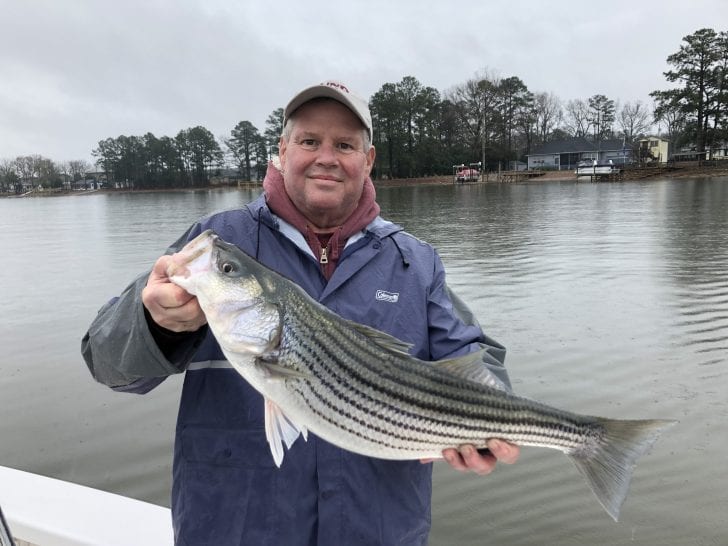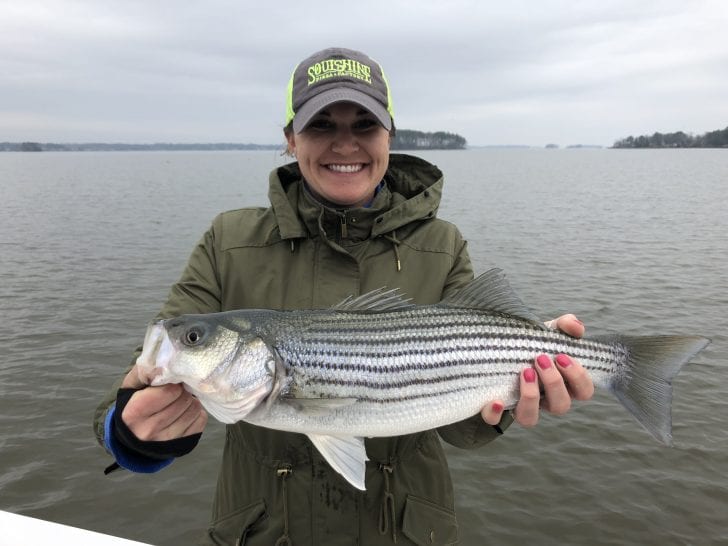by Capt. Craig Price
As a longtime live bait fishermen I was a slow and reluctant convert to trolling artificial’s for stripers. The introduction of hybrids into Lake Norman changed my thinking and I find myself dragging artificial’s almost exclusively during winter. But the approach of spring always brings me back to fishing live bait so now’s a good time for a refresher on how to find, keep, and use local forage to catch quality gamefish.
This forage, generically called shad, are what I call “soft” natural baits. They are rich in oil and protein, and their scales and fins are delicate. These features make them high energy/nutrition sources, and easy for gamefish to digest. They make up the bulk of a growing predatory fish’s diet, which makes them ideal attractants for anglers to use.
By comparison, panfish such as bream, crappie, and perch are “hard” natural baits. Large predators certainly eat panfish but their thicker skins, fins, and scales don’t make them as easy to digest. Even so, I’ve found that stripers especially like big panfish in the spring, and working one or more into your spread often draws big bites. I’ve also found that large stripers really like spotted bass, but see the admonition below about catching and possessing any species with gamefish designation.
I concede that live bait fishing isn’t for everyone. It certainly entails additional effort, and a whole new set of concerns than fishing artificial’s or store-bought minnows. But to help aspiring live bait anglers catch, keep and fish quality live baits, below is a list of do’s and don’ts that will hopefully shorten the learning curve.
- Catching live bait requires a fair amount of physical exertion. Make sure your ability and stamina health-wise are up to the effort.
- Observe all necessary safety precautions, especially in cold and windy conditions, including wearing a PFD, and having proper navigation lighting at night. A companion to help with the labor, boat management, and any emergency is recommended.
- Learn and practice the regulations for catching and possessing live baits, some of which may carry gamefish status. Most gamefish cannot be caught in a cast net, plus creel and size limits must be followed.
- A quality cast net is essential. They come in many sizes, configurations and costs. Locally, a medium quality net with an 8 ft. diameter, minimum 1 lb./ft. of lead, and a 3/8” mesh is a good place to start. TIP – medium quality and cost because stumps, roots and brush piles eat cast nets, and are almost unavoidable when catching bait in local waters.
- A specially designed bait tank is critical for keeping bait in a fresh, lively condition for more than a few hours. Necessary features include oval design, gentle circulation with air infusion, plus filtration. TIPS – cool water holds dissolved oxygen better than warm water. Use frozen jugs of ice to cool the tank water if needed, 55-65F is an ideal target range. Add salt (without iodide or other additives) to the bait tank to soften the water, calm the baits, and promote healthy slime coats, all of which prevents infection and stress. 1 – 1.5 lbs. salt per 30 gals. of water is a good starting point. Put the salt into the filter basket, not directly into the bait chamber. Be aware that putting baits into tank water that is more than 10 degrees colder or warmer than the water they come out of is a quick way to stun and probably kill them.
- Finding shad. The shallow waters, aka mudflats, in the far back reaches of major creeks are prime areas to find threadfin and gizzard shad. Baitfish can often be observed “flipping” on the surface. I find that late afternoon is generally the best time to visit these flats. TIPS – one can learn to use the boat and throws of the net to corral the fish into easier to catch pods and areas. Stealth is important and creeks with any water flow are best.
- The water depth increases as you leave the flats and you are more likely to encounter herring or alewives in depths to 30 ft. A quality sonar is helpful in finding these schools and a larger net with bigger mesh and more weight on the lead line may be needed.
- Baits you catch on the mudflats will be “dirtier” than baits found in deeper water. Frequent changes of filter material and tank water are critical to getting baits through the initial stages of capture. I begin water and filter changes within 20-30 mins. of putting baits in the tank. TIP – red noses and dark backs indicate stressed baits. It’s difficult to save baits that reach this condition and it’s best to remove them from the population well before they die.
- Try to replace at least 1/3 of the water volume each change along with installing fresh filter material and salt. TIP – the most heavily contaminated water will be near the bottom of the bait chamber and in the filter basket. Be sure to siphon or pump out this water plus scales and debris. The period between changes can be increased as the baits get clean, stabilize, and finish purging their body wastes.
TIP – use a large shallow tub with clean lake water in it to dump the net into before putting new baits into your bait tank. This minimizes the amount of mud and debris that you will have to filter from the bait tank. - Using lights at night to attract and catch bait is widely practiced, and offers some advantages over catching shallow water baits. Night time is cooler and less crowded on the water, plus the baits generally come out of deeper water which means they’re cleaner and easier to manage once in your bait tank. I recommend letting someone with experience show you how to operate safely at night in lieu of learning on your own.
The primary goal after catching live baits is to get them into a stable “seasoned” condition, but ultimately you want them to look and swim naturally on the hook in order to attract strikes from top predators. Though the above recommendations are by no means all inclusive, they can serve as a crash course to help you develop your own live bait procedures that result in more Fish On!


Captain Craig Price – Writes articles about fishing
www.folkn.com ~ 704-996-0946
Capt. Craig Price is locally born and raised, and has been fishing the Catawba River and its impoundments since the 1960’s. As his guide business has grown, his area of operations has also grown to include numerous freshwater lakes in NC & SC, plus inshore saltwater charters along the coasts of both states. Beginners to master anglers, live bait to artificial – Capt. Craig enjoys showing his anglers when, where, and how to catch them all.
